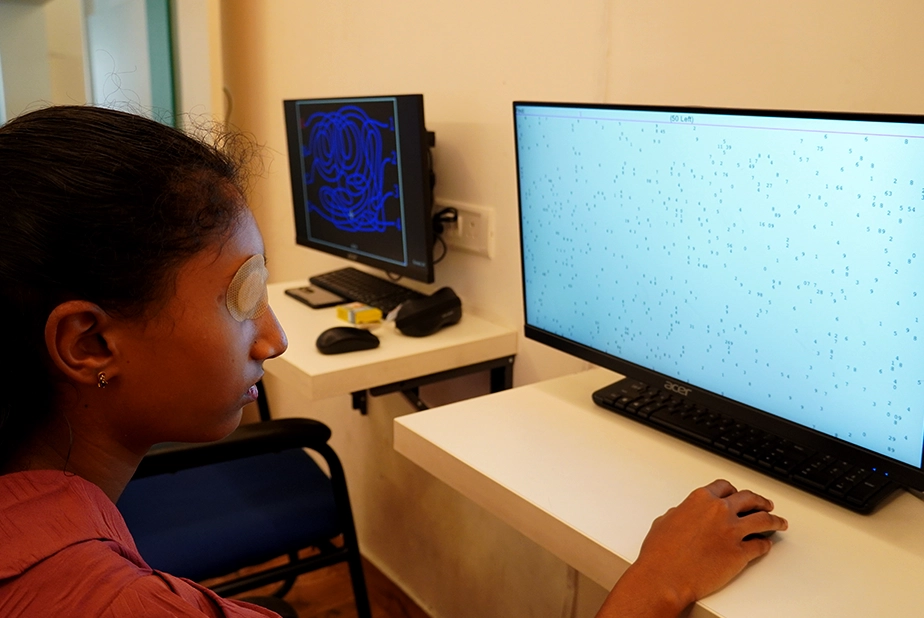Amblyopia Clinic
Amblyopia, commonly known as "lazy eye," occurs when one eye becomes functionally weaker during early childhood.
This often results from conditions such as squint, significant refractive error, cataract, or corneal opacities. When the brain favours the stronger eye, the weaker eye becomes underused, leading to reduced vision—even after the underlying issue is treated.
Early detection and intervention are crucial, as treatment is most effective while the visual system is still developing.
Our Approach
At ABC Clinic, we specialize in delivering individualized care for children using the latest therapeutic methods to strengthen vision and support healthy visual development.
We offer a comprehensive, child-friendly approach that is engaging and scientifically proven.

Our Services Include:
-
Patching Therapy
A traditional and widely used method where the stronger eye is covered for a set duration each day to encourage use of the weaker eye. -
Vision Therapy with Digital Platforms
Customized exercises and digital tools designed to improve visual processing, eye coordination, and focusing abilities in a fun, interactive way. -
Anti-Suppression Techniques
Methods aimed at reducing the brain’s tendency to ignore input from the weaker eye, helping to restore balanced binocular vision. - Computerized Programs and Interactive Games Game-based vision training that keeps children engaged while delivering measurable therapeutic results.
Our goal: Help children achieve optimal vision and strong binocular function through a combination of clinical expertise and compassionate care.
Amblyopia Clinic Brochure
Now Eye Know Videos
What Happens if Lazy Eye is not Treated? | Dr Prajna Ghosh | English
What happens if Lazy Eye is not treated? | Dr Prajna Ghosh | বাংলা ভাষা | Bengali Language
Frequently Asked Questions
What is amblyopia or lazy eye?
Amblyopia occurs when vision in one or both eyes is reduced due to decreased stimulation during early development.
What Causes Amblyopia?
- High uncorrected refractive error (spectacle power)
- Significant difference in power between both eyes
- Visual obstruction from cataracts, drooping eyelids (ptosis), or corneal/lens scarring
- Squint (strabismus) – eye turning inward or outward
- Retinal disease – with a mild component of amblyopia in some cases
Is Vision Loss Due to Amblyopia Reversible?
Yes, if diagnosed early. Treatment should begin promptly after correcting the cause (e.g., prescribing glasses, correcting a squint, or cataract surgery).
Best results are seen when treatment starts before age 8, when the visual connections between the eye and the brain are still developing.
Can Vision Loss Become Permanent?
Yes, if left untreated in early childhood. For example, delaying cataract removal until adolescence can lead to irreversible vision loss due to brain suppression. In such cases, the brain may have permanently suppressed input from the affected eye, leading to poor or limited vision despite successful correction of the physical issue.
Early detection and timely treatment are essential to prevent permanent vision loss due to amblyopia.
Why Do Children Dislike Patching?
Patching forces them to use the weaker eye, which feels frustrating—like using your non-dominant hand for all tasks. However, support, encouragement, and creative strategies can ease the process.
My Child Does Not Use Patches Regularly – What Can I Do?
- For older children: Explain how patching improves their eye strength.
- For younger children: Use themed patches, favourite games, or small rewards.
- Alternative therapies: Interactive digital games or binocular vision therapy using special glasses can be excellent substitutes.
How Do I Know If My Child Is Responding to Treatment?
- Improvement in visual acuity (reading more letters/lines on a chart)
- Amblyopia is considered corrected when both eyes have equal vision
- Additional improvements:
Better contrast sensitivity
Enhanced binocular vision
Improved depth perception
What If I Am Over 18 and Never Treated for Amblyopia?
While treatment is most effective in early childhood, partial improvement is possible up to age 18, depending on the cause.
In adulthood, recovery may not be complete, but significant gains in visual function can still be achieved with consistent therapy, especially for certain causes like unequal spectacle power.